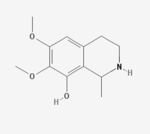Anhalonidine
 | |
| Names | |
|---|---|
| IUPAC name
(1S)-1,2,3,4-Tetrahydro-6,7-dimethoxy-1-methyl-8-isoquinolinol | |
| Identifiers | |
| 17627-77-9 | |
| 3D model (Jmol) | Interactive image |
| ChemSpider | 78662 |
| PubChem | 87201 |
| |
| |
| Properties | |
| C12H17NO3 | |
| Molar mass | 223.27 g·mol−1 |
| Melting point | 160 °C (320 °F; 433 K) [1] |
| Except where otherwise noted, data are given for materials in their standard state (at 25 °C [77 °F], 100 kPa). | |
| Infobox references | |
Anhalonidine a naturally occurring alkaloid which can be isolated from certain members of the cactus family, such as Lophophora.[2] It is structurally related to Mescaline.
See Also
References
- ↑ Späth, Ernst (August 1923). "Über die Anhaloniumalkaloide". Monatshefte für Chemie (in German). 43 (8): 477–484. doi:10.1007/BF01526801.
- ↑ Djerassi, Carl; Smith, C. R.; Marfey, S. P.; McDonald, R. N.; Lemin, A. J.; Figdor, S. K.; Estrada, H. (June 1954). "Alkaloid Studies. III.1 Isolation of Pilocereine and Anhalonidine from Four Cactus Species". Journal of the American Chemical Society. 76 (12): 3215–3217. doi:10.1021/ja01641a034.
This article is issued from Wikipedia - version of the 9/1/2016. The text is available under the Creative Commons Attribution/Share Alike but additional terms may apply for the media files.